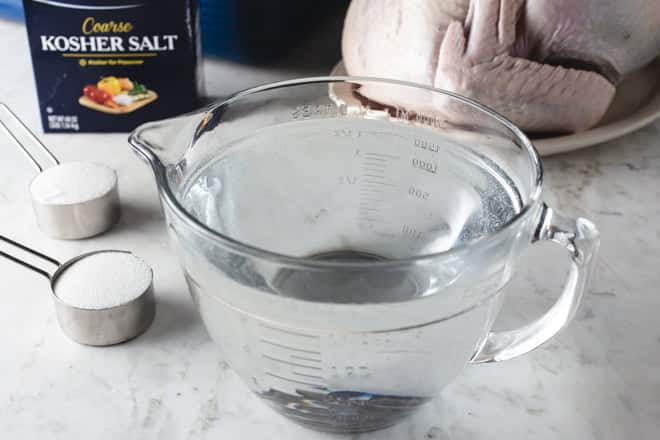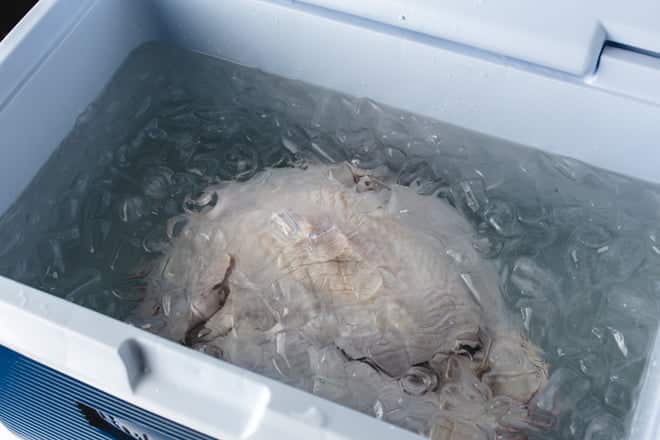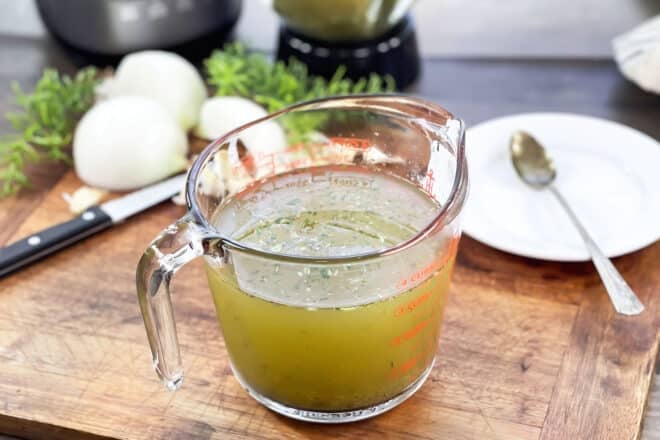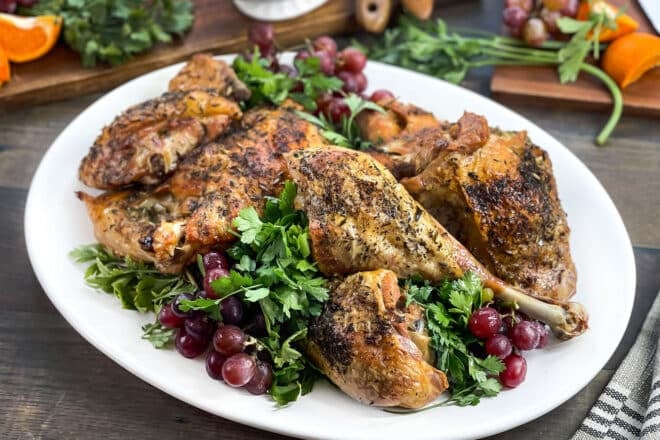A miraculous way to roast a turkey that uses butter-covered aluminum foil to protect the breast from the high heat while basting it. The foil is removed at the end so that the skin can crisp up. This article also talks about brining and whether or not you should do it. It also has a lot of tips for roasting a turkey perfectly.
You probably know that my parents owned and operated restaurants when I was growing up. What you might not know is that they also did a lot of catering. We estimate that they’ve catered over a thousand turkey dinners, with each dinner requiring numerous turkeys. Their dinners have always gotten great reviews, and now I’m going to show you how my mom roasts a turkey perfectly. We will first talk about what size turkey you need, and then we will talk about how to cook it (basting and crisping the skin with butter!) so that the meat is perfectly cooked and juicy. Even the breast meat is juicy.
Covering your turkey with aluminum foil while it roasts may seem like an obvious move – after all, you want a moist, juicy bird right? But foil can actually work against you if used improperly. Here’s a complete guide to answering the question: should I cover my turkey with aluminum foil?
The Benefits of Using Foil
Covering your turkey with foil for most of the roasting time provides some big benefits:
-
Prevents Drying Out: The foil traps moisture and steam around the turkey, keeping it from drying out in the hot oven. This is especially helpful for the breast meat, which dries out easily.
-
Promotes Even Cooking: The foil helps the turkey cook evenly, especially for birds over 12 pounds. It prevents the outer areas from overcooking while the inner areas get up to temperature.
-
Saves You Time A covered turkey roasts more quickly than an uncovered one shaving off up to 30 minutes of cook time. The foil allows the heat to penetrate and cook the meat faster.
-
Easy Cleanup: Keeping the turkey covered contains most of the mess – no need to scrub burnt drippings off the bottom of your roasting pan!
When to Avoid Using Foil
While foil provides some clear advantages. there are times when you don’t want to use it
-
Crisping the Skin Foil will steam the skin and prevent it from crisping Always uncover the turkey for the last 30-60 minutes for deliciously crispy skin
-
Smoking/Grilling: Don’t cover turkeys cooking over indirect heat or on a grill. The foil prevents smoke from reaching and flavoring the meat.
-
Self-Basting Birds: Turkeys with built-in basting systems don’t need foil since they already lock in moisture. Foil may actually over-steam these birds.
-
Small Birds: 12 pound turkeys and under don’t require foil since they roast quickly and are less prone to drying out.
How to Cover Your Turkey
Covering your turkey properly ensures you get all the benefits of foil without any downsides:
-
Use heavy-duty aluminum foil to withstand oven heat without tearing. Standard foil can leak steam.
-
Make a foil tent by molding 2-3 sheets into a loose, tent-like shape over the turkey. This allows heat and some air circulation.
-
Avoid wrapping tightly, which leads to steaming. You want the moisture to drip and roast rather than pool.
-
Cover any exposed areas like wings or legs to prevent burning. But keep the foil loose here as well.
-
Add a sheet of foil underneath the turkey to catch drips for an easy cleanup.
-
Remove foil 30-60 minutes before the turkey is done for crispy, golden skin.
Other Ways to Keep Turkey Moist
Using foil is a great way to prevent turkey dryness, but you can also incorporate these other moisturizing methods:
-
Brine the turkey in a saltwater solution before roasting – this seasons the meat and helps it retain moisture.
-
Rub butter under the skin over the breast meat to baste from the inside out as it roasts.
-
Start breast side down so gravity pulls moisture into the breast as it cooks initially. Flip over later for browning.
-
Baste frequently with pan drippings to moisturize the skin if uncovered.
-
Cook to the proper internal temp. Overcooking is the #1 cause of dry turkey. Use a meat thermometer.
To Foil or Not to Foil?
So when all is said and done, should you cover your turkey with foil or not? Here are some general tips:
-
Cover turkeys over 12 pounds with foil for most of the roasting time. Remove it 30-60 minutes before finished.
-
Use foil for self-basting birds only if struggling with dryness or to speed up cook time.
-
Feel free to skip the foil for smaller birds under 12 pounds – Brining is a better option here.
-
Always foil when smoking, grilling or deep-frying turkeys to prevent burning and drying out. Remove it toward the end.
-
Ultimately, know your options and experiment to find your ideal balance of juicy meat and crispy skin!
Following these tips will allow you to perfectly roast your turkey with or without foil. The right technique depends on your bird, cooking method and personal preference. So go ahead and cover that turkey this Thanksgiving – as long as you keep an eye on it and uncover at the end, you’ll be rewarded with a mouthwatering holiday centerpiece.

Brine Or No Brine?
We never brined the turkeys when catering. And if you think about it, that makes sense. There needs to be a lot of cooler space to keep 10 turkeys in cold water for hours. So, I will say that you absolutely do not have to brine your turkey. Also, the recipe below assumes you didn’t brine the bird. If you did brine it, it will still work; just leave out the salt that you added before roasting.
If you’re trying to decide whether to brine or not, I have a bit to say. First, you can find out more about what brining is and how it works over here. When you brine your turkey, you put it in a solution of water and salt. The turkey’s meat soaks up the liquid, making it more juicy and seasoning it all over.

It can be a bit of a pain to brine a turkey though. When someone tells you how to brine a turkey, the most important thing is usually that you keep the turkey and the solution cold the whole time. This can take hours. People do things like this with a big cooler and ice because it’s hard to fit a container big enough to hold a turkey in your fridge.

That’s seriously overkill to me. My preference is to therefore do a dry-brine. For this, you’re mixing salt and other seasonings together and rubbing them directly onto the turkey. That goes into the fridge for a day or two. Turkey juices are drawn out by the salt and then reabsorbed, but with the salt and seasonings’ flavor added. So the flavors and the tenderizing properties of the salt get right into the meat. Putting the salted turkey in the cool fridge also makes the outside dry, which makes the skin extra crispy when you roast it. You can learn more about how to dry-brine a turkey over here.

If you really want to make a wet brine, I suggest one that has a lot of flavor and a lot of salt. This allows you to cut the brining time down by quite a bit, making it more convenient. This is the best turkey brine recipe I know of.

A special method is used to make a flavor slurry in a blender or food processor. This really pulls the flavors out of the ingredients (onion, garlic, and herbs), making it easier for the turkey to take them in faster. It also has that high concentration of salt that I was talking about.
A final thing about brining. You can brine and then roast turkey parts instead of a whole turkey if you really want to wet brine but don’t have enough room. You can even just roast boneless turkey breasts if that’s what works best for your family.
You can buy more of the parts you want and skip the ones you don’t want. This way, the turkey takes less time to thaw and brine, takes up less space in the fridge and the oven, and the skin gets crispier because it’s more exposed. Plus, no more fighting over the drumsticks! The only major con is that you don’t have a turkey to carve at the table. But if you don’t already carve at the table, that won’t matter. You can try this by following these steps: how to roast turkey parts and how to brine them.

Now that we’ve talked about whether to brine a turkey and how to do it, let’s talk about how to roast the turkey. This technique is really unique and involves topping the turkey with some aluminum foil spread with butter. That buttered foil keeps the breast meat moist while basting the turkey as it cooks. You remove the foil at the end and then that exposed buttery skin crisps up to perfection. Let’s learn how to do it!.
Instructions For Roasting Turkey
Take the turkey out of the fridge 30 minutes before you cook it. This will make it less cold and help it cook more evenly. If you haven’t brined your turkey, just take it out of the box and pat it dry with paper towels. Don’t rinse it off since that only sprays potential bacteria around your kitchen. If you wet-brined your turkey, also just pat it dry, no need to rinse it. If you dry-brined your turkey, don’t do anything. It looks like a lot of seasoning is about to fall off in the picture above, but that was just the start of the process. By then end, it’s the finest of layers and you want to leave it on there.
If your turkey has giblets inside, you can do one of three things:
1) You can discard them;
2) You can make turkey broth with them to add to the beef drippings when you make gravy. This is a great idea if you’re brining the turkey because the turkey juices might get too salty. You can use this broth instead. To do this, put the giblets (removed from any packaging) into a medium saucepan. You can also remove any extra skin or fat from the turkey and add that. You can even add the wing tips, which don’t have much meat on them and often turn too dark when roasted. Only add enough water to the pan to barely cover the meat. In this case, less is more, since less water means the flavor will stay strong. Sage, thyme, rosemary are some of the fresh herbs that you can add. You can also use dried herbs or poultry seasoning, as well as raw onion, garlic cloves, carrots, and celery. You don’t have to peel the carrots or celery, and you can leave the peels on the onions and garlic. Just give everything a good rinse. Don’t add salt because that will make it harder to get your gravy seasoning right later. Give it all a stir, some items might be sticking out and that’s actually ideal. Bring the pot to a boil over high heat, stirring occasionally, and then reduce it to a simmer. Let it sit there simmering for 30 minutes to an hour, stirring every now and then. Remove from the heat and strain away the aromatic pieces. Those can be discarded so that all is left is the broth.
3) Add them to the roasting pan, putting them around the turkey as it roasts. This will add extra flavor to your gravy. They will be strained out and thrown away before the gravy is served. Just mush them up a bit before you make the gravy.
Should I cover the turkey with foil while it cooks in the oven?
FAQ
Is it better to cook a turkey covered or uncovered?
Do you cover a turkey with aluminum foil while cooking?
Is it better to cook a turkey at 325 or 350?
Are turkey bags better to use rather than covering turkey with foil?
Should I Cover my Turkey with aluminum foil?
Using aluminum foil to cover your turkey remains a highly debated topic in the world of cooking. Some swear by it, while others find the practice unnecessary. Here are some pros and cons of using aluminum foil to cover your turkey. One of the main benefits of using aluminum foil to cover your turkey is that it helps to lock in moisture.
What happens if you cover a Turkey with foil?
Can Cause Uneven Cooking: Certain parts of the turkey like the breast and thighs can end up cooking at different rates when covered with foil. Uncovered promotes even browning and cooking throughout. Steams the Turkey: Trapping moisture under foil leads to wet heat and turkey that steams rather than roasts.
Why do I need to remove foil when cooking a Turkey?
Foil can prevent the skin of the turkey from browning evenly. This is because the foil acts as a barrier between the turkey and the heat. If you want to ensure that the skin of your turkey browns evenly, you will need to remove the foil for the last 30 minutes of cooking time. * Can make it difficult to check the internal temperature of the turkey.
Should you wrap a Turkey in foil?
Firstly, don’t wrap the turkey too tightly in aluminum foil, as this can prevent heat and steam from circulating around the meat, causing it to dry out. Leave some space between the foil and the bird, or just cover the breast area. Secondly, consider adding some moisture to the turkey before wrapping it in foil.
Should you cover a turkey breast with foil?
Simply tent the foil so that it loosely covers the whole turkey. Some recipes suggest only covering the breast as this is the part prone to dryness, but it can’t hurt to make sure the rest of the turkey is tented with foil, too.
Do you need a foil for roasting a Turkey?
But if you are roasting the turkey, be it whole turkey, breast, or leg on a regular roasting pan, foil is a good option. Basically the foil works in the same way a lid works—by trapping steam so the turkey stays moist throughout the roasting process. Simply tent the foil so that it loosely covers the whole turkey.
